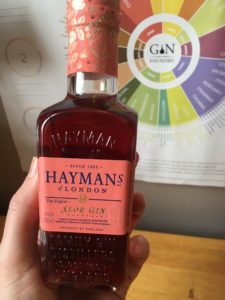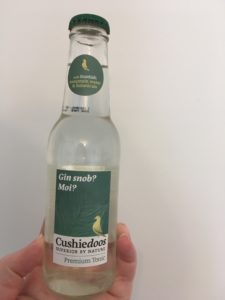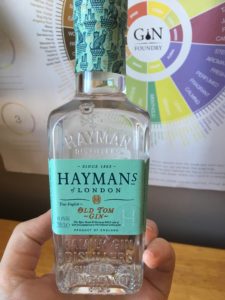 Today is exciting because it’s an extra Craft Gin Club day (shout out to Lizzie for sorting my delivery problems)! I’m not meant to get my next subscription box until September, but when I saw what was in the box this month, I had to get one ASAP. Dry Island Gin is the lovechild of two great distilleries, Four Pillars in Australia and Herno in Sweden, and this is their Eurpoean exclusive launch! Being mutual fans of each other’s work, they got chatting and after discovering they had a lot in common and throwing around some ideas, they decided to collaborate and work together. The first step sounded like a lot of hard work – tasting the whole Herno and Four Pillars range side by side to work out what characteristics from their current range should go into the collaboration. They decided to aim for a classic gin using Swedish meadowsweet and Australian river mint, strawberry gum and roasted wattleseed to bring together a range of flavours and textures. This is a Four Pillars gin, made in Australia using their base spirit and the pure water which is one of the aforementioned pillars, with Jon from Herno weighing in with the distillation. Removing Four Pillars’ still plates, Jon recommended they distil at a lower temperature over a longer period to for higher purity. I’ve waited long enough, so let’s crack this open.
Today is exciting because it’s an extra Craft Gin Club day (shout out to Lizzie for sorting my delivery problems)! I’m not meant to get my next subscription box until September, but when I saw what was in the box this month, I had to get one ASAP. Dry Island Gin is the lovechild of two great distilleries, Four Pillars in Australia and Herno in Sweden, and this is their Eurpoean exclusive launch! Being mutual fans of each other’s work, they got chatting and after discovering they had a lot in common and throwing around some ideas, they decided to collaborate and work together. The first step sounded like a lot of hard work – tasting the whole Herno and Four Pillars range side by side to work out what characteristics from their current range should go into the collaboration. They decided to aim for a classic gin using Swedish meadowsweet and Australian river mint, strawberry gum and roasted wattleseed to bring together a range of flavours and textures. This is a Four Pillars gin, made in Australia using their base spirit and the pure water which is one of the aforementioned pillars, with Jon from Herno weighing in with the distillation. Removing Four Pillars’ still plates, Jon recommended they distil at a lower temperature over a longer period to for higher purity. I’ve waited long enough, so let’s crack this open.
blog
Symphonia No.2 Gin
Note: Symphonia kindly sent me a sample to try and ramble about, but as always I’ll let you know if I’m not a fan.
 Did you read about Symphonia No.1 gin? If not, shame on you and you can read it here. The second gin in their range is a bit more unusual as it is an apple gin. This isn’t a flavoured gin liqueur, this is a full on 40% gin made with crisp Bramley apples from Ireland which pairs with the juniper to create what they say is a gin filled with floral and herbal notes. Did you know that the apples grown in County Armagh have protected geographical status as the growing conditions out there are pretty unique? Apparently this creates the apple with the lowest sugar content but the highest acidity content, which Symphonia use to their advantage to flavour their gin. They counteract the sweetness of the apple with spice from ginger root and coriander.
Did you read about Symphonia No.1 gin? If not, shame on you and you can read it here. The second gin in their range is a bit more unusual as it is an apple gin. This isn’t a flavoured gin liqueur, this is a full on 40% gin made with crisp Bramley apples from Ireland which pairs with the juniper to create what they say is a gin filled with floral and herbal notes. Did you know that the apples grown in County Armagh have protected geographical status as the growing conditions out there are pretty unique? Apparently this creates the apple with the lowest sugar content but the highest acidity content, which Symphonia use to their advantage to flavour their gin. They counteract the sweetness of the apple with spice from ginger root and coriander.
Hayman’s Sloe Gin
Note: I love the Hayman’s team and they kindly sent me some samples, but as always, I’ll let you know what I think.
 You’ve hopefully already read my thoughts on the Hayman’s London Dry and Old Tom gins, and today we are trying their sloe gin. A lot of sloe gins can be too sickly sweet which I find a bit cloying, so it will be interesting to see how this fares. To make their gin they steep wild harvested sloe berries in their London Dry gin for three to four months using, as always, a traditional family recipe. Sloe gin is generally seen as a winter drink, but they suggest pairing it with some sparkling wine for a different take on a kir royale style cocktail.
You’ve hopefully already read my thoughts on the Hayman’s London Dry and Old Tom gins, and today we are trying their sloe gin. A lot of sloe gins can be too sickly sweet which I find a bit cloying, so it will be interesting to see how this fares. To make their gin they steep wild harvested sloe berries in their London Dry gin for three to four months using, as always, a traditional family recipe. Sloe gin is generally seen as a winter drink, but they suggest pairing it with some sparkling wine for a different take on a kir royale style cocktail.
Symphonia No.1 Gin
Note: I met the Symphonia team at Junipalooza and they sent me home with some samples to try properly. As usual, I’ll let you know what I think.
 Symphonia gin is a fairly nerdy brand. Founded by Ric Dyer (who has a PhD in organic chemistry) in 2016, he decided to use his skills and experience to create innovative spirits with a focus on local flavours and ingredients. In the heart of rural Ireland, Symphonia is distilled using a knowledge of flavour molecules to create their balanced compositions. This ‘composition’ carries through to their branding with the musical notation on the label – which FYI is the notation of the makeup of the gin. Symphonia No.1 is a mix of citrus, local herbs and flowers and ending with spice.
Symphonia gin is a fairly nerdy brand. Founded by Ric Dyer (who has a PhD in organic chemistry) in 2016, he decided to use his skills and experience to create innovative spirits with a focus on local flavours and ingredients. In the heart of rural Ireland, Symphonia is distilled using a knowledge of flavour molecules to create their balanced compositions. This ‘composition’ carries through to their branding with the musical notation on the label – which FYI is the notation of the makeup of the gin. Symphonia No.1 is a mix of citrus, local herbs and flowers and ending with spice.
Horse Guards Gin
Note: I contacted the Horse Guards gin team and they kindly sent me a sample to try, but as always, I’ll let you know what I really think.
 Horse Guards gin is inspired by the Horse Guards, a group set up by King Charles II in 1661 to provide him with a higher level of protection. During the span of the Horse Guards time, it’s produced a number of pioneers (aka Colonel Frederick Gustavus Burnaby who was the first person to make a hot air balloon trip from England to France and Christina Broom who became the first female press photographer in the UK) whose sense of adventure inspired the team behind the gin. They lead with juniper and balance it with citrus (orange and grapefruit) and a hint of spice from some cardamom.
Horse Guards gin is inspired by the Horse Guards, a group set up by King Charles II in 1661 to provide him with a higher level of protection. During the span of the Horse Guards time, it’s produced a number of pioneers (aka Colonel Frederick Gustavus Burnaby who was the first person to make a hot air balloon trip from England to France and Christina Broom who became the first female press photographer in the UK) whose sense of adventure inspired the team behind the gin. They lead with juniper and balance it with citrus (orange and grapefruit) and a hint of spice from some cardamom.
Cushiedoos Tonic
Note: I contacted the Cushiedoos team and they kindly sent me some samples to try but as always, I’ll let you know what I think.
 Cushiedoos is a new brand of tonic water from Edinburgh, but there’s something about it that makes it very different to everything else. This tonic water has no quinine in it. Which made me think, does it actually count as tonic water? They say it does so until I’m told otherwise, we’ll go with yes. Cushiedoos start with Scottish mountain water from the Cairngorns National Park which is then blended with Scottish heather and silver birch, plus some gentian and wormwood for bitterness (replacing the quinine) and British sugar beet to balance this with a touch of sweetness. They have an eye out for the environment, ensuring that all of their ingredients are close to home – plus as it is all natural and contains no added sugar, there is around 24% less sugar than other premium tonic waters. Cushiedoos is a Scottish word for a wood pigeon, who apparently partner up for life, like gin and tonic… Also fun fact for you: the samples arrived just as I was leaving to go on holiday to Edinburgh, and I spent the beginning of my gin tasting talking about the brand which they then bought out for us to try. Small world. Anyway, on with the tasting!
Cushiedoos is a new brand of tonic water from Edinburgh, but there’s something about it that makes it very different to everything else. This tonic water has no quinine in it. Which made me think, does it actually count as tonic water? They say it does so until I’m told otherwise, we’ll go with yes. Cushiedoos start with Scottish mountain water from the Cairngorns National Park which is then blended with Scottish heather and silver birch, plus some gentian and wormwood for bitterness (replacing the quinine) and British sugar beet to balance this with a touch of sweetness. They have an eye out for the environment, ensuring that all of their ingredients are close to home – plus as it is all natural and contains no added sugar, there is around 24% less sugar than other premium tonic waters. Cushiedoos is a Scottish word for a wood pigeon, who apparently partner up for life, like gin and tonic… Also fun fact for you: the samples arrived just as I was leaving to go on holiday to Edinburgh, and I spent the beginning of my gin tasting talking about the brand which they then bought out for us to try. Small world. Anyway, on with the tasting!
Hayman’s Old Tom gin
Note: I love the Hayman’s team. After visiting their distillery and trying all their gin, they kindly sent me some samples.
 If you’ve been paying attention, you’ll have read my blog post about Hayman’s London Dry gin. Well, guess what? I have more gin! Today I am trying their Old Tom gin which, as a style, is one of my favourites. You may or may not know but a Tom Collins is one of my favourite drinks. The Hayman’s version of Old Tom gin is heavy on the citrus and juniper to create a rich mouthfeel, which then has an undercurrent of sweetness that lets you know you are drinking an Old Tom rather than London Dry.
If you’ve been paying attention, you’ll have read my blog post about Hayman’s London Dry gin. Well, guess what? I have more gin! Today I am trying their Old Tom gin which, as a style, is one of my favourites. You may or may not know but a Tom Collins is one of my favourite drinks. The Hayman’s version of Old Tom gin is heavy on the citrus and juniper to create a rich mouthfeel, which then has an undercurrent of sweetness that lets you know you are drinking an Old Tom rather than London Dry.
Pothecary Gin
Note: I met Lukasz from Pothecary gin at Junipalooza and he kindly sent me a bottle to try – as always, you’ll know if I don’t like it.
 Pothecary gin was created because two friends share a passion for artisan – and organic – produce. This isn’t a London Dry style gin, they label theirs as “British blended” because they do things a bit differently over at Pothecary HQ. They distil each botanical separately and then blend these together before adding the water to lower the ABV. I’m not sure I’ve come across another gin that uses this method – gins that add flavours after the distillation certainly, but distilling each botanical on it’s own? Let me know if that is less unique than I think. Alongside the usual suspects of lemon peel (organic) and juniper (foraged) they use only three more botanicals – organic lavender and wild foraged tilia flowers and black mulberries (also organic). So how does this taste?
Pothecary gin was created because two friends share a passion for artisan – and organic – produce. This isn’t a London Dry style gin, they label theirs as “British blended” because they do things a bit differently over at Pothecary HQ. They distil each botanical separately and then blend these together before adding the water to lower the ABV. I’m not sure I’ve come across another gin that uses this method – gins that add flavours after the distillation certainly, but distilling each botanical on it’s own? Let me know if that is less unique than I think. Alongside the usual suspects of lemon peel (organic) and juniper (foraged) they use only three more botanicals – organic lavender and wild foraged tilia flowers and black mulberries (also organic). So how does this taste?
Doctor Polidori Tonic
Note: I met the Doctor Polidori team and they kindly gave me some bottles to try, but as always I’ll let you know what I REALLY think.
 Doctor Polidori tonic comes from Germany from the same people that make Ferdinand’s Saar gin, and I think we’re all thinking the same thing. Who the hell is Doctor Polidori? To know this we have to open our history books to around the time of Lord Byron, Polidori’s client and travelling companion (and originator of the vampire-fiction genre). His records formed the foundation of this modern interpretation of tonic. They have two tonics in their range – the dry tonic which is infused with botanicals such as basil and thyme and a cucumber tonic which includes (funnily enough) cucumber extract which makes the tonic “a refreshing experience beyond compare”. So, how do they taste?
Doctor Polidori tonic comes from Germany from the same people that make Ferdinand’s Saar gin, and I think we’re all thinking the same thing. Who the hell is Doctor Polidori? To know this we have to open our history books to around the time of Lord Byron, Polidori’s client and travelling companion (and originator of the vampire-fiction genre). His records formed the foundation of this modern interpretation of tonic. They have two tonics in their range – the dry tonic which is infused with botanicals such as basil and thyme and a cucumber tonic which includes (funnily enough) cucumber extract which makes the tonic “a refreshing experience beyond compare”. So, how do they taste?
Twelve Keys gin
Note: I met the Twelve Keys team on their launch day at Junipalooza and they kindly gave me their final bottle to put on the blog, but as always, I’ll let you know what I think.
 Twelve Keys gin is new. Brand new. I mean they literally launched at Junipalooza on 9 June. They also have a beautiful man in their advertising. But that’s irrelevant (it’s not). Inspired by Basil Valentine – a 15th century alchemist – the twelve botanicals vary from honey (from their own wildflower meadow) to fig, quince, basil and apricot. The fruits are balanced with caraway, frankincense and cinnamon to create a rounder flavour. When I tried this at Junipalooza, they garnished this with a coffee bean and a small piece of fig, and the coffee bean added a depth to the flavour – and I don’t even like coffee!
Twelve Keys gin is new. Brand new. I mean they literally launched at Junipalooza on 9 June. They also have a beautiful man in their advertising. But that’s irrelevant (it’s not). Inspired by Basil Valentine – a 15th century alchemist – the twelve botanicals vary from honey (from their own wildflower meadow) to fig, quince, basil and apricot. The fruits are balanced with caraway, frankincense and cinnamon to create a rounder flavour. When I tried this at Junipalooza, they garnished this with a coffee bean and a small piece of fig, and the coffee bean added a depth to the flavour – and I don’t even like coffee!